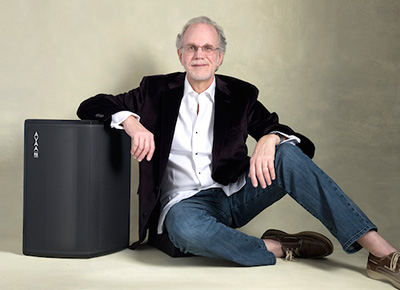Mastering engineer Bob Katz employs three PSI Audio AVAA C20 active bass traps as part of the acoustic control in his Florida studio.
 In order to achieve the acoustic response he is aiming for, Katz combined conventional absorption with the AVAA system. The Active Velocity Acoustic Absorber affects the acoustic impedance of the surrounding air, sucking out the low frequencies – almost as if there was a hole in the wall. A mic measures acoustic pressure and a transducer membrane is used to eliminate room modes more efficiently than a traditional absorber several times the size of a C20.
In order to achieve the acoustic response he is aiming for, Katz combined conventional absorption with the AVAA system. The Active Velocity Acoustic Absorber affects the acoustic impedance of the surrounding air, sucking out the low frequencies – almost as if there was a hole in the wall. A mic measures acoustic pressure and a transducer membrane is used to eliminate room modes more efficiently than a traditional absorber several times the size of a C20.
Treating the frequency range between 15Hz and 150Hz, the AVAA C20 can take care of most modal resonances – without affecting the direct sound of the monitors, as EQ solutions would. The impressive effect the PSI Audio AVAA C20 can have on the acoustics of a room can go beyond its nominal frequency range, as eliminated bass frequencies will not mask higher frequencies, and the reduction of reflected sound also increases the clarity of sonic space.
The song material also determines the use of analogue or digital signal processors. ‘If a recording requires an extremely transparent approach, I might use all digital gear,’ Katz says. ‘But if a recording is lacking in tone or needs some warmth, I can more often achieve best results with some of my analogue processors, be it tube or solid state, or a combination of the two. And in order to be able to make a judgment, I need to have the finest acoustics.’
Katz explains the importance of a neutral and linear listening environment with the graphic aid of a bell curve: ‘When the loudspeakers in your room fall right in the middle of the curve between the bassiest, thumpiest, ugliest sounding speakers you have ever heard on the one side, and the brightest, harshest, thinnest system you have ever heard on the other side, then you are going to be able to translate from your mastering room to the widest variety. That is why you want the best and most accurate acoustics to make your judgments – it will translate to the widest variety of listeners.’
Traditional trapping tends to overattenuate the upper mids and higher frequencies, while bass frequencies are very hard to treat with classic absorbers. But a mastering engineer’s room needs to be consistent over frequency and time: ‘You need a reasonably large room which has been treated to produce an even Schroeder curve, meaning that the reverberation with respect to frequency is even throughout the octaves.’ Katz says.
‘My jaw dropped,’ Katz says of his first encounter with the Swiss bass trap. ‘The AVAA responds to pressure changes at any frequency from 15Hz to 150Hz, so if there is a problem at one frequency or another, it will take care of it transparently. It doesn’t add any colouration, it doesn’t distort, it just takes care of it.’
The AVAA C20 has a further feature not commonly asked for in acoustic elements: portability. ‘A year after I got the AVAAs, I changed my loudspeaker system and the new speakers are located about one foot further away from me than the previous loudspeakers,’ Katz recounts. ‘I also moved the subwoofers, to work in tandem with the new mains position, so the entire low frequency resonance points, the modal character of my room changed.’
Instead of bass resonances in the corners, Katz now had tangential modes building up between front and rear wall. While conventional acoustic elements would have been attached to the walls and quite hard or even impossible to move, the PSI Audio system made adjusting the acoustics easy.
‘I was able to pick up the AVAA traps, move them out of the corners and distribute them across the back wall instead. It almost seems to defy the laws of physics: How can something that small and lightweight deal with 20Hz frequencies?
‘People might wonder why we put in so much effort when the result is only going to be listened to on a cheap stereo system or a pair of headphones connected to a smartphone,’ he muses. ‘The answer is that the better the master I can make, the better it will sound on any piece of gear.
‘It is kind of a miracle that you can play back 96kHz and 192Hz files via the internet,’ he adds. ‘No more MP3s, no more low resolution stuff – because MQA [Master Quality Authenticated, a digital high quality audio codec] is allowing us to do that.’
Katz hopes for a new generation of audiophiles, growing up with high-resolution audio streaming, and by extension a growing demand for high-quality masters. With his experience, finely tuned ears and a mastering room sweetened by PSI Audio AVAA C20s, he stands at the ready to shape the future of audio.














